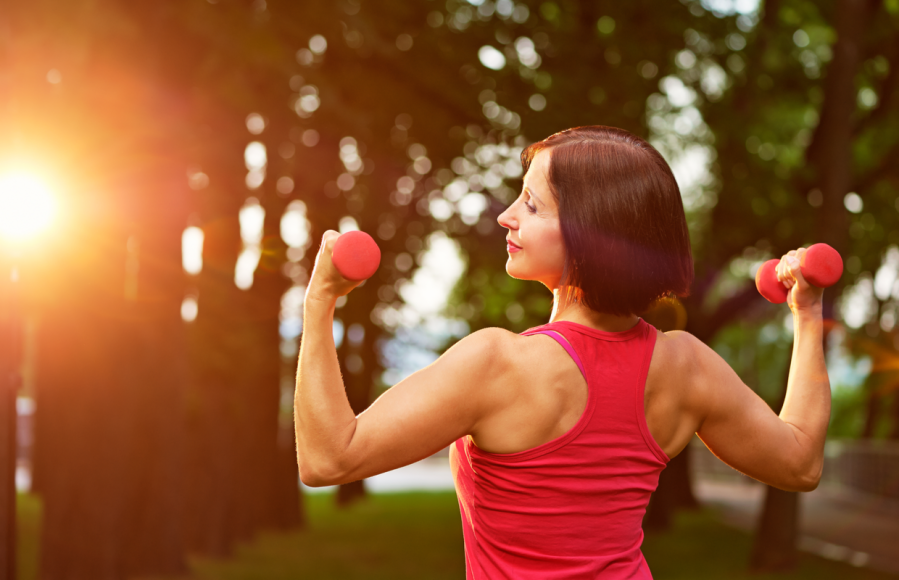Forming the structure of your body, your bones are your foundations. But when did you last think about their health? Read on to discover how to strengthen your bones naturally as you age and avoid osteoporosis, through simple diet and lifestyle changes…
Your body naturally replenishes your bones throughout your life. But by your 40s and into menopause this process slows down. So, looking after your bones is essential. With lifestyle, nutrition and exercise choices from the experts, you can learn how to strengthen your bones naturally at any age. If you do something positive for your bones each day, you’ll be safeguarding your future bone health.
Many patients of women’s health expert Dr Shahzadi Harper at The Harper Clinic are concerned about bone fractures and loss of mobility. ‘Menopause is a risk factor for low bone mineral density (BMD) because the hormone oestrogen is essential to the bone building process.
‘When you go through menopause, oestrogen production drops and, therefore, so does your natural ability to maintain and produce bone. If BMD continues to fall, you may develop osteoporosis. This is a disease where bones become brittle and fragile, and more likely to fracture,’ she says.
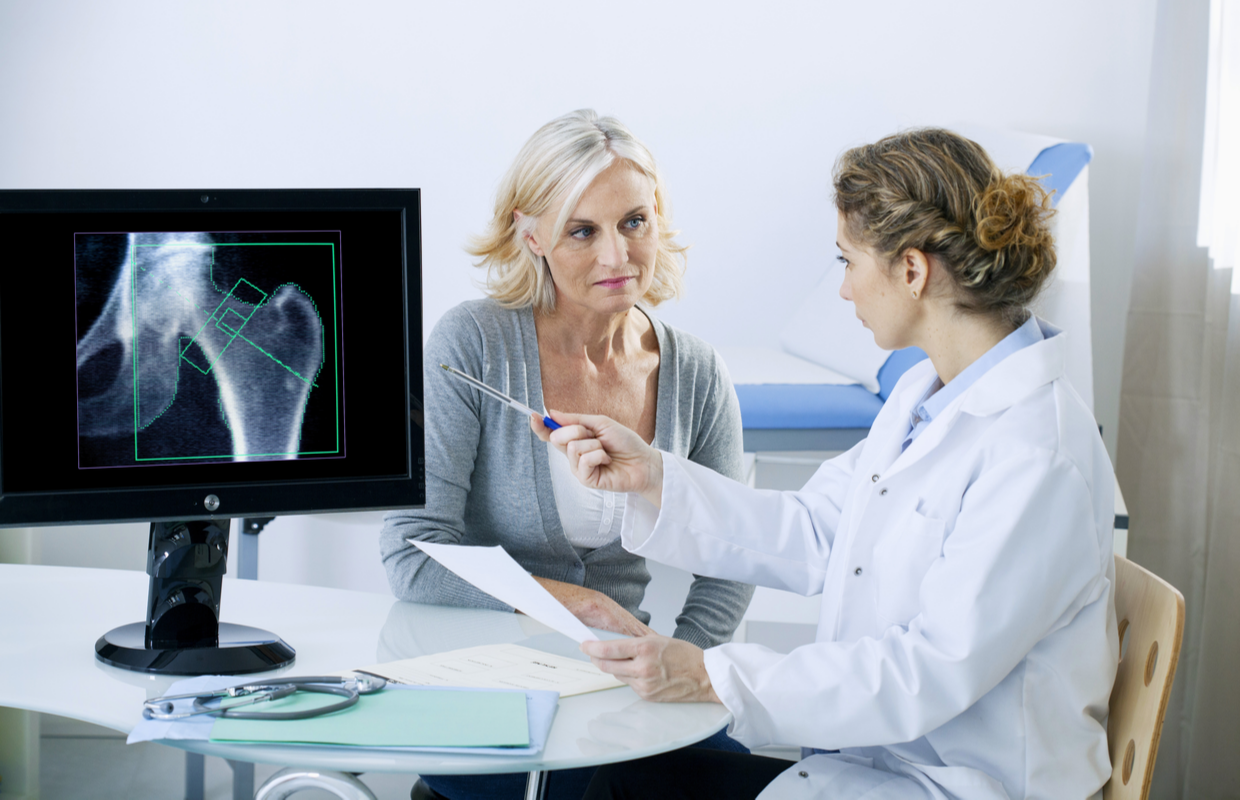
The first outward sign of osteoporosis is when you fracture a bone from standing or a low height – usually the wrist, hip or spine.
Signs of osteoporosis:
Osteoporosis is known as ‘the silent disease’ because you can’t see it or feel it. The first outward sign of osteoporosis is when you fracture a bone from standing or a low height – usually the wrist, hip or spine. Other warning signs are receding gums, back pain, neck pain, weak, brittle nails and loss of height.
‘Bones are made up of a thick outer shell and a strong inner mesh consisting of protein (collagen), calcium and other minerals that look like a tight honeycomb – a bit like a Crunchie bar. Bones form in a process called bone remodelling, when cells called osteoclasts break down removing old bone and cells called osteoblasts form new bone,’ says Dr Harper.
‘With osteoporosis and the condition that precedes it – called osteopenia – this honeycomb structure has increasingly larger spaces, making the bones lose their strength. So, the outside wall of the bones becomes thinner, making them vulnerable to even the slightest knock or impact. These are progressive bone conditions which will continue to worsen unless you actively do something about them. But the good news is there’s plenty you can do to help your bones – and prevention is better than cure,’ she says.
Check your bone density
If you think you might have osteoporosis symptoms, a good way to check bones is to have a DEXA scan. This is an X-ray that measures and scores your BMD against healthy bones. The difference is given as a T-score. Positive T-scores indicate your bones are stronger than normal, while negative T-scores indicate bones are weaker than normal. The World Health Organization defines osteopenia and osteoporosis like this:
- Normal bone density: T score between +1 and -1
- Osteopenia: T score between -1 and -2.5
- Osteoporosis: T score of -2.5 to -4.0 or below
In the UK, DEXA scans require a referral by the NHS, which may prove difficult if you don’t meet the criteria. If you don’t get referred, a scan at a private clinic costs around £100.
If you can’t get a DEXA scan, it may be worth trying the new OsteoTest (£149). You send a urine sample to a lab to assess your calcium balance to show if you’re losing calcium or building bone mass.
6 ways to strengthen your bones naturally as you age
While decreased bone density is a naturally part of ageing, especially for women following the menopause, there are things you can do to support your bone health as you age. Here’s how to strengthen your bones naturally and avoid osteoporosis…
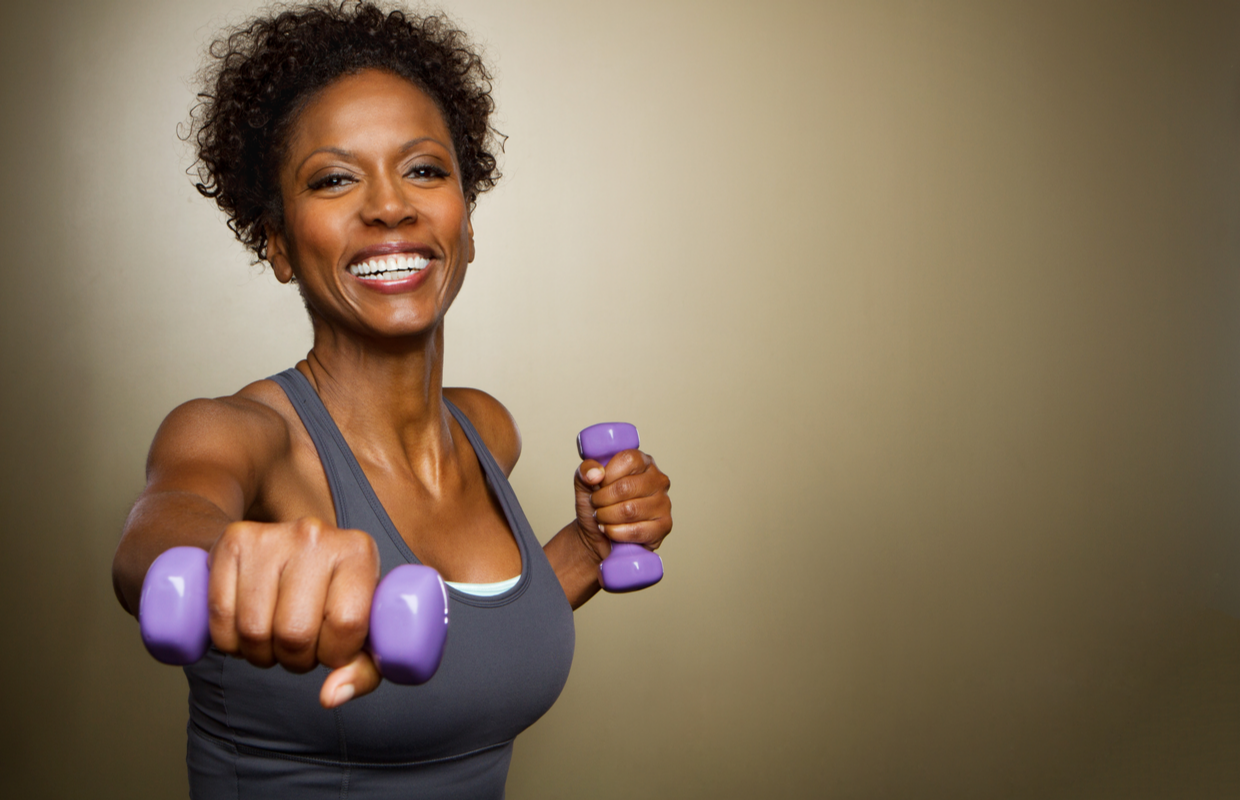
Resistance exercises are particularly beneficial for strengthening your bones.
1. Exercise regularly
Exercise is excellent for your bones. There are two types of movements that you should include in your workouts for the best bone boosting results, advises midlife fitness expert and founder of Menohealth, Julie Robinson. Weight-bearing exercises are when you lift your own body weight, as you work against gravity. This includes walking, jogging, dancing, or climbing stairs.
‘For bone health, you need to include activities that create impact or jolt, such as hopping or skipping. Research found hopping for two minutes a day can strengthen hip bones. But make sure you wear trainers, soften landing for your knee and build up length of times gradually to give your body time to adapt.’
Best exercises for bone health
Resistance exercises are lifting, pushing or pulling against a force, such as with dumbbells, gym equipment or resistance bands. Good examples are biceps curls using different strength bands or hand weights. Or side-leg raises using a loop band around the ankles to create resistance and make your muscles work harder.
‘You can create resistance doing everyday activities such as lifting bags of shopping rather than using a trolley or pushing a heavy
wheelbarrow when gardening,’ says Julie.
Exercising with osteoporosis
If you’ve been diagnosed with osteopenia or osteoporosis, you may feel fragile, but don’t stop moving as it’s beneficial for you. Start off slowly, gradually increasing the time and intensity over several weeks. Find an exercise instructor who has knowledge and expertise in this area so you can confidently enjoy exercising without the risk of injury.
For example, you may be advised to replace jumps and hops with purposeful stepping instead. ‘Many exercises can be adapted so they are safe and beneficial. But avoid sudden and rapid twisting of the spine, and be cautious when doing abdominal crunches or sit-ups. Care must be taken with exercises that involve bending or twisting forcefully at the waist, such as golf, tennis and some yoga poses,’ says Julie.
For a mood-lifting, bone-strengthening session to do at home, click here.
2. Top up your vitamin D levels
Vitamin D and calcium are essential to build and maintain healthy bones. When taken as supplements, they ought to be taken together as vitamin D is needed for the uptake of calcium from the gut into the bloodstream, from where it passes to the bones, says nutritional therapist and naturopath Caroline Peyton.
‘I recommend taking a vitamin D3 supplement all year round as most people do not get enough sun exposure for the body to make enough vitamin D.’ You can also find vitamin D from food sources in egg yolks, mushrooms, fortified milk and fatty fish.
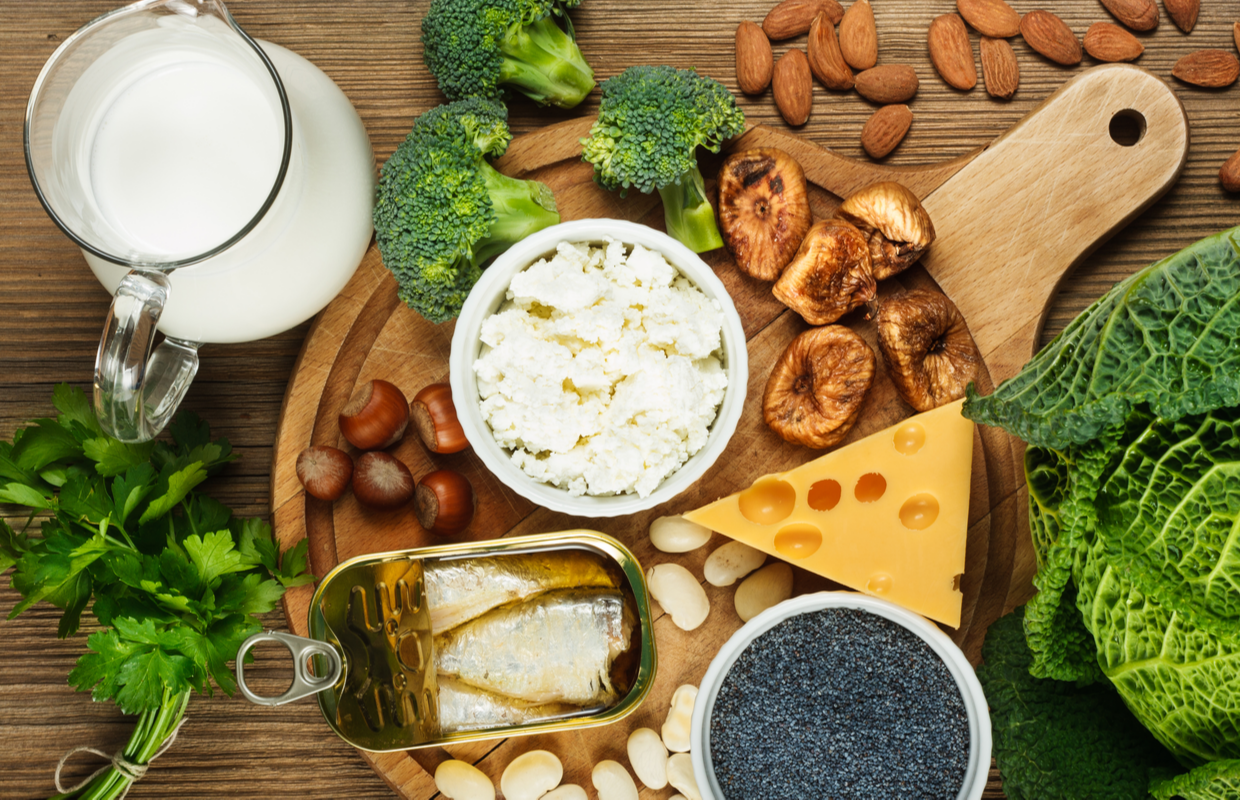
Sardines, sesame seeds and dark green leafy vegetables are all great sources of easily-absorbable calcium.
3. Eat calcium-rich foods
Nutritionist and bone health expert Benedetta Andreotti advises getting calcium from food. ‘Sardines, sesame seeds and dark green leafy vegetables are all great sources. You might think dairy foods are good, but as they are magnesium-poor, the calcium absorption rate may be reduced.’
She also advises caution when taking any calcium supplements. ‘At normal doses, calcium supplementation may cause bloating, gas and constipation. And at very high doses it can cause kidney stones and blood clots, as high calcium levels in the blood are stored along the artery walls, which contributes to the narrowing of blood vessels,’ she says. If you’re taking calcium, make sure to take it with D3 (see box left) and check your levels with your GP.
4. Supplement with collagen
Bones need to be strong and hard, but they also need to be flexible to absorb impact in the event of a fall or knock. Collagen is key to giving flexibility and tensile strength to bones, allowing them to resist stress and impact.
It’s important to know different collagens have different sized molecules or peptides, which are absorbed into different body tissues. For example, the collagen you take for your skin, hair, nails or joints won’t improve your bones. So, choose a collagen specifically targeted for bone health.
‘Collagen supplementation has been associated with healthier skin, less joint pain, muscle mass, a healthier heart and strong bones. As the building block of our bones, it is found in animal-based products. This includes beef, chicken, pork and fish. Increase collagen production by eating proline- and glycine-rich foods, such as egg whites, wheatgerm, asparagus, chicken skin, and bone broth,’ says Benedetta.
TRY THIS! Bioactive collagen peptides found in bone balance (£39.99) are optimised to reach bone tissue. It is a flavourless powder that dissolves into drinks for the dietary management of low bone mineral density. This includes osteopenia and osteoporosis. Clinical studies show it compares favourably with medications prescribed for osteoporosis, without the side effects of medication.
Following a plant-based diet? Click here for our round-up of the best vegan collagen supplements.
5. Try a bone builder device
Low-intensity vibration (LiV) therapy from the Marodyne LiV device (£2,995) is scientifically researched to build bone density, plus prevent and combat osteoporosis. The device provides an exact low-level vibration (0.4g) transmitted at a high frequency (30Hz). This is the precise intensity required to stimulate the body’s bone-building cells into action.
Developed in conjunction with NASA to help reduce the bone mineral density loss astronauts experience in space, the machine has been fine-tuned for home use. Stand on it for 10 minutes a day to prompt your bone building cells into action. Suitable for all, the gentle buzz of the device has been likened to a cat purring!
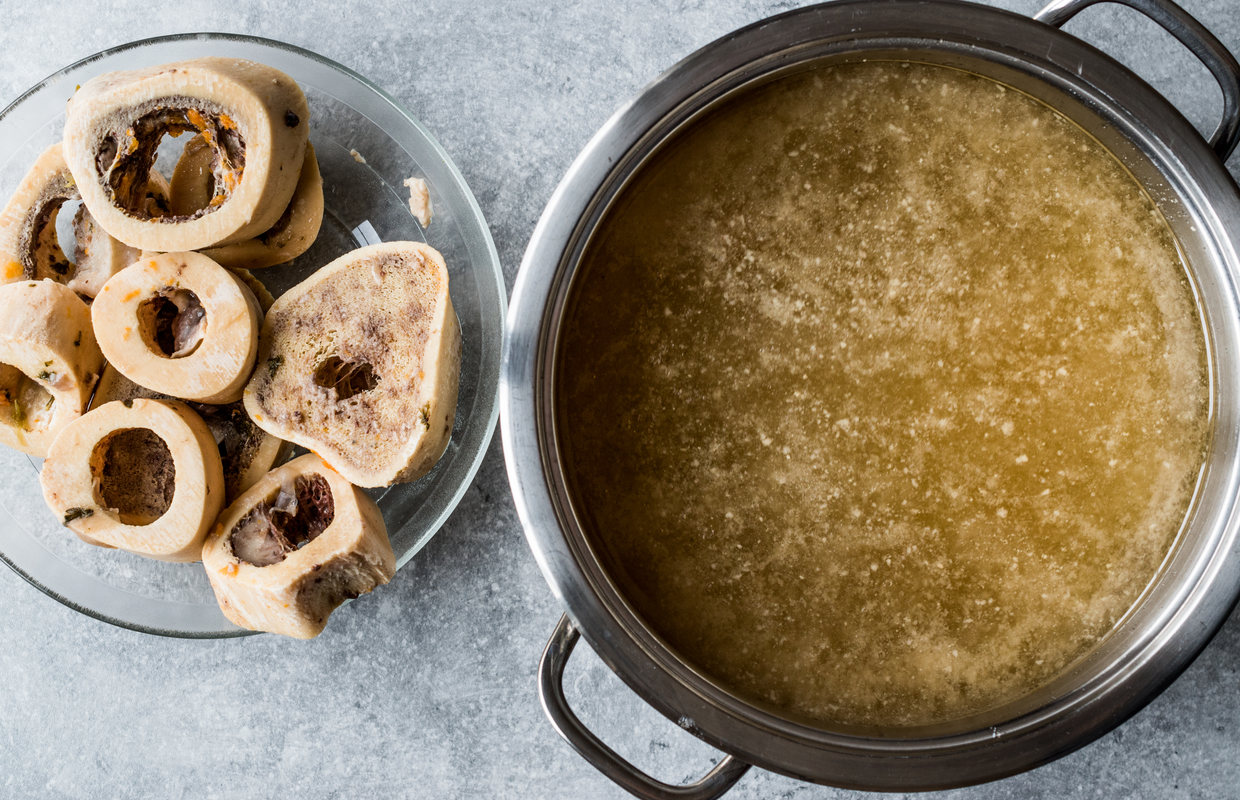
Bone broth can help to increase collagen production and, as a result, maintain healthy joints and bones.
6. Alter your diet to support bone health
Best foods to strengthen your bones:
- FISH: This includes canned sardines and salmon (with bones), and fatty fresh varieties, such as salmon, mackerel, tuna and sardines, are good sources of calcium, vitamin D and collagen.
- GREEN LEAFY VEGETABLES: Collard greens, turnip greens, kale and broccoli are all examples of vegetables rich in calcium that improve bone health.
- FORTIFIED FOODS: These include breakfast cereals, soy milk, juices and breads containing calcium and vitamin D.
- BONE BROTH: This can help to increase collagen production and, as a result, maintain healthy joints and bones.
- DAIRY PRODUCTS: Whole milk, yoghurt, kefir and cheese are rich in calcium – make sure you increase vitamin D and magnesium-rich foods, too
Foods to avoid:
- FIZZY DRINKS: These contain phosphoric acid, which can cause calcium (which is alkaline) to be drawn from bones.
- CAFFEINE: Whether in coffee, tea or soft drinks, caffeine can decrease calcium absorption and contribute to bone loss.
- WHEATBRAN: This contains high levels of phytates, which can prevent calcium absorption. If you have milk with wheatbran cereal, your body might only absorb a small amount of calcium from the milk.
Related: Slipped (herniated) disc – causes, treatment and prevention
Words: Katherine Selby | Images: Shutterstock

